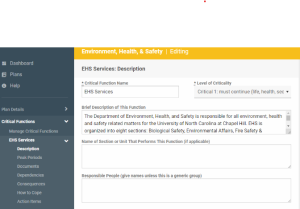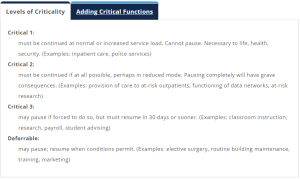Welcome to the latest edition of the Mission Ready newsletter. In this issue, we focus on empowering Continuity Plan Managers in identifying critical functions. Critical functions refer to the essential activities, processes, and services that a department/unit must perform to ensure its financial solvency, meet legal and regulatory requirements, and maintain its overall operational integrity during and after a disruptive event. These functions are crucial for sustaining the university’s mission to promote teaching, research, and public service.
Why Are Critical Functions Important?
 Critical functions are important for several reasons, particularly in the context of Mission Continuity. Understanding and prioritizing critical functions play a crucial role in the university’s ability to effectively prepare for, respond to, and recover from disruptions or emergencies. Here are some reasons why critical functions are important:
Critical functions are important for several reasons, particularly in the context of Mission Continuity. Understanding and prioritizing critical functions play a crucial role in the university’s ability to effectively prepare for, respond to, and recover from disruptions or emergencies. Here are some reasons why critical functions are important:
- Sustaining Core Operations
- Critical functions represent the essential activities and processes that are central to the university’s day-to-day operations. Ensuring the continuity of these functions is vital for sustaining the lifelines that contribute to the university’s success.
- Minimizing Financial Impact
- Disruptions to critical functions can have significant financial consequences for the university. Identifying and prioritizing these functions facilitates the allocation of resources and the development of strategies to minimize financial losses during and after a disruption.
- Preserving Brand Reputation
- The ability to maintain critical functions during a disruption reflects positively on the university’s resilience and preparedness. This can help preserve the university’s brand reputation and promote long-term impacts such as enrollment and research prospects.
- Reducing Downtime
- Quick recovery of critical functions minimizes downtime and allows the university to resume normal operations more rapidly.
Identifying Critical Functions
Identifying critical functions is a fundamental step in developing a Mission Continuity plan. Departments/units can conduct business impact analysis (BIA) to assess the potential consequences of disruptions to various department functions. Based on the analysis outcome, critical functions are identified and prioritized, taking into account factors such as financial impact, regulatory compliance, and the university’s overall mission. To help facilitate identification, examine the key characteristics of critical functions:
- Essentiality
- Critical functions are indispensable to the department/unit’s survival and success. They are core activities that directly contribute to the achievement of the department/unit objectives and the mission of the university.
- Interdependencies
- Critical functions often have interdependencies with other functions and systems within the university. Disruptions in one area may have cascading effects on related processes.
- Time Sensitivity
- Critical functions may be time-sensitive, with specific deadlines or requirements that must be met. Timely recovery of these functions is essential for maintaining operations. Restoration should be prioritized for critical functions that must resume within 30 days.
- Resource Dependencies
- Critical functions may require specific resources, such as technology, personnel, facilities, or specialized equipment. Identifying and securing these resources is crucial for Mission Continuity planning.
- Regulatory Compliance
- Critical functions often involve activities that are subject to legal and regulatory requirements. Ensuring compliance during and after a disruption is a key consideration.



